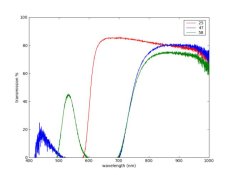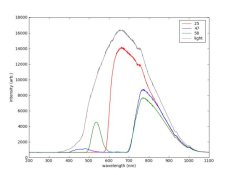Thought some of you might find this interesting. I was playing around with the new spectrometer in the lab and my 25, 47, and 58 Tiffen filters happened to get delivered today. So I made transmission curves for them. Note the source light was just a crummy flashlight which is pretty light on the blue end of the spectrum, so the curves are a bit skewed (there's only so much the software can compensate for). I did a quick test using window light and the transmission hump in the blue end of the spectrum for the 47 filter was about 30%, compared to the 20% from the flashlight.
The other graphic is the actual output of the spectrometer for each of the three filters and the source flashlight.
Notice the HUGE amount of IR that all three of the filters lets through.
The other graphic is the actual output of the spectrometer for each of the three filters and the source flashlight.
Notice the HUGE amount of IR that all three of the filters lets through.














